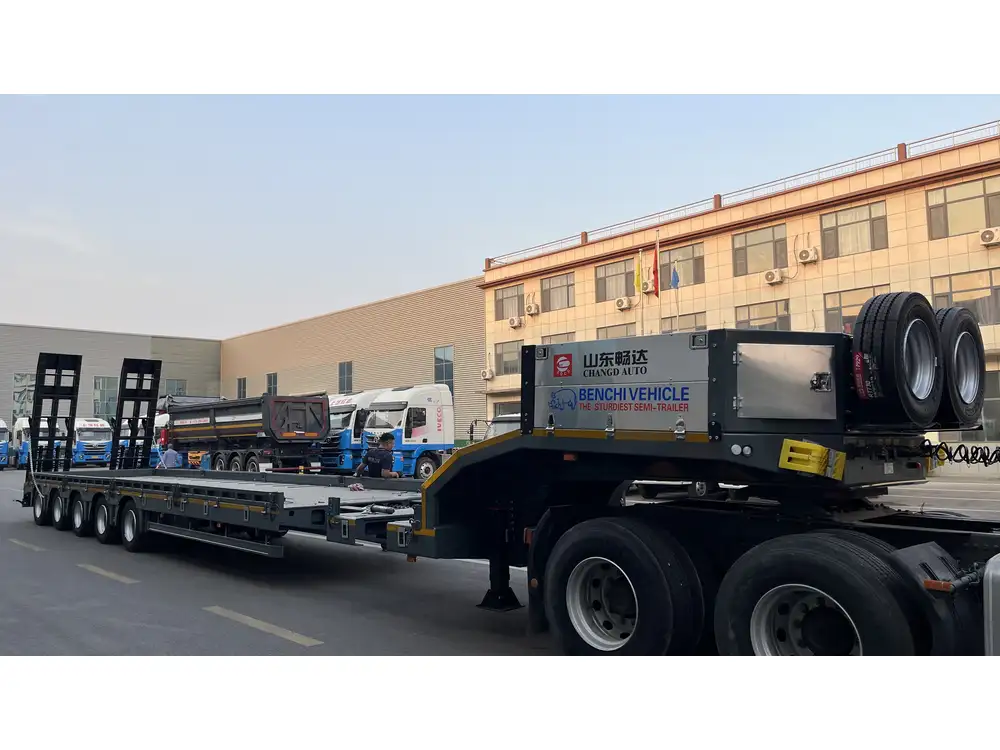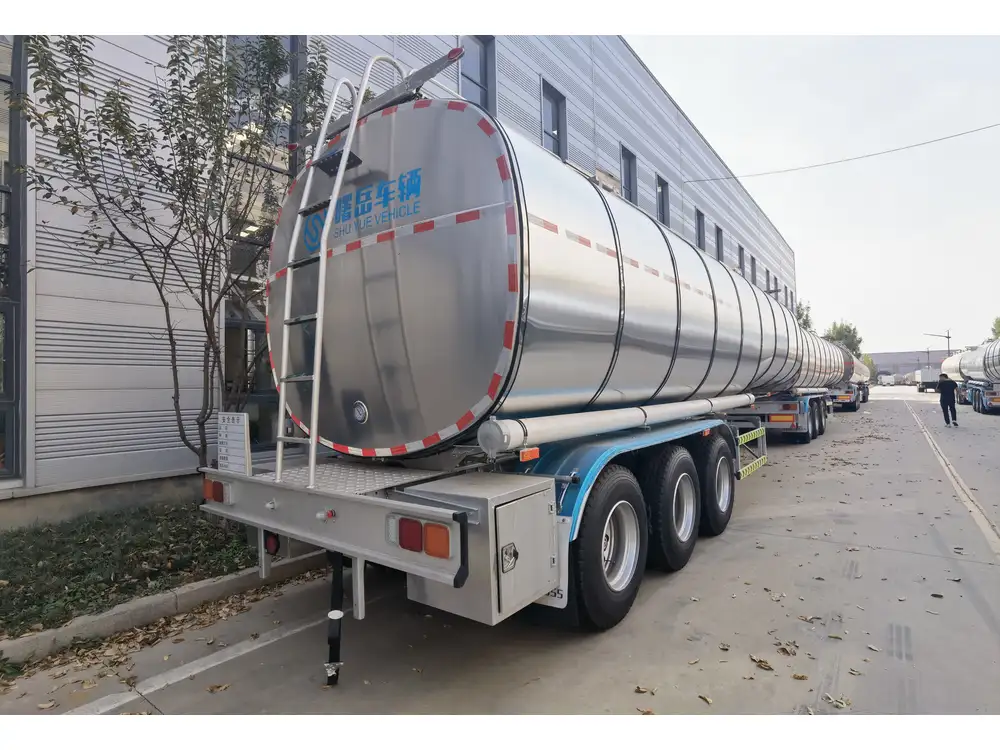As the demand for cleaner and more efficient transportation solutions accelerates, Compressed Natural Gas (CNG) has emerged as a viable alternative fuel for semi-trailers. At CarMax Vehicle, we understand the critical role that CNG tanks play in ensuring the performance, safety, and sustainability of your fleet. This guide delves into the various CNG tank types available, offering an in-depth analysis to help you make informed decisions for your semi-trailer needs.
Understanding Compressed Natural Gas (CNG) in Transportation
Compressed Natural Gas (CNG) is a fossil fuel substitute that is both cost-effective and environmentally friendly. When compressed to high pressures, typically between 3,000 to 3,600 psi, natural gas becomes a compact energy source suitable for vehicular use. CNG offers numerous advantages, including lower emissions, reduced fuel costs, and enhanced engine performance, making it an attractive option for semi-trailer operations.
Types of CNG Tanks
CNG tanks are classified into four primary types based on their construction and materials. Each type offers distinct benefits and is suited to different applications and requirements.

1. Type I CNG Tanks
Material Composition: Type I tanks are constructed entirely of aluminum or steel. The metal shell serves as both the pressure vessel and the protective layer.
Characteristics:
- Durability: High resistance to physical damage and corrosion.
- Cost: Generally more affordable due to simpler manufacturing processes.
- Weight: Heavier compared to other types, which may impact vehicle payload capacity.
Applications: Ideal for applications where budget constraints are significant, and the extra weight can be accommodated without compromising performance.
2. Type II CNG Tanks
Material Composition: These tanks feature a liner made of aluminum or steel, wrapped with a high-strength fiber, typically polyester or glass fiber, reinforced with resin.
Characteristics:
- Weight: Lighter than Type I tanks, enhancing fuel efficiency and payload capacity.
- Flexibility: Better resistance to impact and environmental stress.
- Cost: Moderately priced, balancing performance and affordability.
Applications: Suitable for medium to high-capacity storage needs in semi-trailers, offering a compromise between weight and durability.
3. Type III CNG Tanks
Material Composition: Type III tanks utilize an aluminum liner reinforced with a carbon or glass fiber composite. The outer shell provides additional strength and protection.
Characteristics:
- Weight: Significantly lighter than Type I and II, improving overall vehicle efficiency.
- Strength: High pressure tolerance and superior durability.
- Cost: More expensive due to advanced materials and manufacturing techniques.
Applications: Preferred in high-performance semi-trailers where weight reduction and maximum strength are paramount.

4. Type IV CNG Tanks
Material Composition: These tanks consist of a plastic or composite liner encapsulated by a high-strength carbon fiber shell.
Characteristics:
- Weight: The lightest among all types, offering maximum payload capacity.
- Safety: Exceptional resistance to corrosion and environmental factors.
- Cost: Highest in cost, reflecting the cutting-edge materials and technology used.
Applications: Best suited for premium semi-trailers that require the utmost in weight efficiency and durability, despite the higher initial investment.
Comparative Analysis of CNG Tank Types
To better understand the distinctions and advantages of each CNG tank type, the following table provides a side-by-side comparison based on key factors:
| Feature | Type I | Type II | Type III | Type IV |
|---|---|---|---|---|
| Material | Aluminum/Steel | Aluminum/Steel + Fiber | Aluminum + Carbon/Glass Fiber | Composite/Liner + Carbon Fiber |
| Weight | Heavier | Moderate | Light | Lightest |
| Pressure Rating | Up to 3,600 psi | Up to 3,600 psi | Up to 3,600 psi | Up to 3,600 psi |
| Durability | High | High | Very High | Extremely High |
| Cost | Low | Moderate | High | Very High |
| Safety | Good | Good | Excellent | Superior |
| Typical Use | Budget applications | Standard applications | Performance-focused | Premium applications |
Choosing the Right CNG Tank for Your Semi-Trailer
Selecting the appropriate CNG tank type depends on various factors, including budget, payload requirements, and operational demands. Here’s a step-by-step approach to making the right choice:

1. Assess Your Budget
- Type I: Best for cost-sensitive operations.
- Type IV: Ideal for those willing to invest in advanced technology for long-term benefits.
2. Evaluate Payload Requirements
- Heavier Payloads: Type IV and III tanks offer lighter alternatives, maximizing payload capacity.
- Moderate to Light Payloads: Type II tanks provide a balanced solution.
3. Consider Durability and Safety
- High Durability Needs: Type III and IV tanks are superior.
- Standard Durability Needs: Type I and II tanks suffice.

4. Analyze Fuel Efficiency Goals
- Maximize Efficiency: Opt for lighter tanks like Type III or IV.
- Balanced Efficiency: Type II tanks offer moderate improvements.
5. Future-Proofing
- Advanced Technologies: Type IV tanks position your fleet for future advancements in CNG infrastructure and regulations.
Benefits of Using CarMax Trailer CNG Tanks
At CarMax Vehicle, we specialize in manufacturing CNG tanks that cater to the diverse needs of the modern transportation sector. Our CNG tanks are engineered with precision, ensuring optimal performance and reliability. Here’s why our CNG tanks stand out:

Superior Material Quality
Utilizing high-grade aluminum and composite fibers, our CNG tanks provide unparalleled strength and longevity, mitigating the risks associated with high-pressure gas storage.
Lightweight Construction
Our Type III and IV tanks are designed to reduce overall vehicle weight, enhancing fuel efficiency and increasing payload capacity without compromising on safety.
Advanced Safety Features
Incorporating the latest safety standards, our CNG tanks are equipped with pressure relief devices, robust valves, and protective shells to ensure safe operations even under extreme conditions.

Customizable Solutions
Understanding that each fleet has unique requirements, we offer customizable CNG tank configurations, enabling seamless integration with various semi-trailer models.
Competitive Pricing
Despite the advanced features, our CNG tanks are competitively priced, providing excellent value for investment and ensuring a high return on operational efficiency.
Installation and Maintenance of CNG Tanks
Proper installation and regular maintenance are crucial for the longevity and safety of CNG tanks. Here’s how CarMax Vehicle ensures seamless integration and upkeep:

Installation Process
- Professional Assessment: Our team conducts a thorough evaluation of your semi-trailer to determine the optimal CNG tank type and placement.
- Customized Mounting: We offer tailored mounting solutions to ensure the CNG tanks are securely fixed, maintaining vehicle balance and stability.
- Safety Integration: Incorporating necessary safety systems, including pressure monitoring and emergency shut-off mechanisms.
- Regulatory Compliance: Ensuring all installations comply with local and international safety standards and regulations.
Maintenance Practices
- Regular Inspections: Scheduled inspections to detect and address any signs of wear, corrosion, or damage.
- Pressure Testing: Routine pressure tests to ensure tanks maintain integrity under operational conditions.
- Cleaning Protocols: Keeping tanks free from contaminants to prevent internal corrosion and maintain fuel purity.
- Timely Repairs: Prompt repairs or replacements of faulty components to uphold safety and performance standards.
Future Trends in CNG Tank Technology
The landscape of CNG tank technology is continually evolving, driven by advancements in materials science and increasing environmental regulations. Here are some emerging trends:

Integration of Smart Technologies
- Sensors and IoT: Incorporating sensors for real-time monitoring of pressure, temperature, and tank integrity, enabling proactive maintenance.
- Data Analytics: Utilizing data to optimize fuel efficiency and predict maintenance needs.
Enhanced Material Innovations
- Nanomaterials: Exploring the use of nanocomposites to further reduce weight while enhancing strength.
- Recyclable Materials: Developing tanks with recyclable components to support sustainability initiatives.
Improved Safety Mechanisms
- Advanced Valves: Implementing smart valves that respond dynamically to pressure changes.
- Impact-Resistant Designs: Enhancing tank structures to better withstand accidents and external forces.

Modular Design Concepts
- Scalability: Designing tanks that can be easily scaled or reconfigured to meet varying fuel storage needs.
- Ease of Installation: Creating modular tank systems that simplify installation and maintenance processes.
Conclusion
Choosing the right CNG tank type is pivotal to optimizing the performance, safety, and efficiency of your semi-trailer fleet. At CarMax Vehicle, we are committed to providing top-tier CNG tank solutions that cater to your specific needs, backed by cutting-edge technology and unparalleled expertise. By understanding the distinct features and advantages of each CNG tank type, you can make informed decisions that drive your business forward in the evolving landscape of clean transportation.
Frequently Asked Questions

1. What are the main differences between Type III and Type IV CNG tanks?
Answer: Type III CNG tanks feature an aluminum liner reinforced with carbon or glass fiber composites, offering a balance between weight and durability. Type IV tanks, on the other hand, utilize a plastic or composite liner encapsulated by a high-strength carbon fiber shell, making them the lightest and most durable option, though they come at a higher cost.
2. How often should CNG tanks be inspected for safety?
Answer: Regular inspections are crucial for maintaining the safety and integrity of CNG tanks. It is recommended to conduct comprehensive inspections at least once a year, with additional checks after significant events such as accidents or prolonged heavy usage.
3. Can CNG tanks be retrofitted into existing semi-trailers?
Answer: Yes, CNG tanks can be retrofitted into existing semi-trailers. However, it is essential to have the installation performed by certified professionals to ensure proper integration, compliance with safety standards, and optimal performance.

4. What maintenance practices can extend the lifespan of a CNG tank?
Answer: To extend the lifespan of a CNG tank, adhere to regular inspection schedules, perform routine pressure testing, keep the tanks clean from contaminants, and promptly address any signs of wear or damage. Additionally, ensuring proper storage conditions can prevent unnecessary stress on the tanks.
5. Are there environmental benefits to using CNG over traditional diesel fuel in semi-trailers?
Answer: Yes, using CNG as a fuel source offers significant environmental benefits over traditional diesel. CNG combustion produces lower levels of harmful emissions, including CO2, NOx, and particulate matter, contributing to reduced greenhouse gas emissions and improved air quality.



